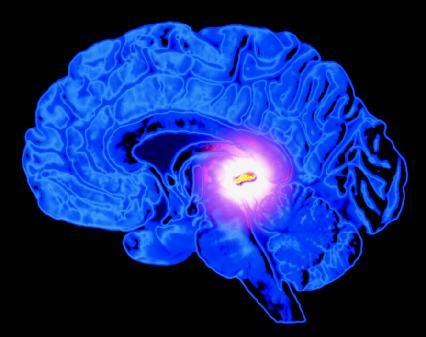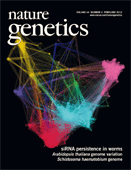
英法两国科学家最新发表在《自然遗传学》杂志上的一项研究表明,负责调节人体生物钟的激素——褪黑激素与Ⅱ型糖尿病有直接关系,那些褪黑激素受体基因罕见变异的人群患Ⅱ型糖尿病的几率更高。这一发现将有助于科学家更精确地评估糖尿病患病风险,并开发出更具针对性的个性化治疗方法。
过去有研究发现,经常上夜班的人患上Ⅱ型糖尿病和心脏病的风险更高,而如果一个人的睡眠连续三天被反复打断,也会出现暂时性糖尿病症状。人体的睡眠周期是由褪黑激素调节控制的,这种激素不仅会对体内胰岛素的释放水平进行调控,也有致人困倦、降低体温的效果。早在2008年英国伦敦帝国理工大学进行的一项遗传研究就曾发现,那些褪黑激素受体MT2基因仅是普通变异的人,患Ⅱ型糖尿病的风险就会较常人略高。
为了寻找更加罕见的致病基因变异,由英法两国多家研究机构科学家组成的研究小组对7632个人的MT2基因进行了筛查。在他们发现的40个与Ⅱ型糖尿病相关的基因变异中,有4种变异非常罕见,会使得受体完全无法对褪黑素产生反应。通过与11854个样本对比,研究人员最后确认了这4种基因变异与Ⅱ型糖尿病之间确有关联,每一种变异都会使人患Ⅱ型糖尿病的风险大增,其患病几率是无基因变异人群的6倍。研究人员认为,MT2基因变异会破坏人体生物钟与胰岛素释放之间的内在联系,从而导致血糖水平异常。
领导该项研究的伦敦帝国理工大学的菲利普·弗洛格尔教授指出,人体生物钟会控制诸多生理进程,血糖水平控制是其中重要一项。这一研究表明,生物钟的关键调控基因是会影响糖尿病患病风险的,MT2基因的罕见变异对人体的影响远比普通变异要大得多。弗洛格尔教授表示,尽管每一种基因变异都不能说是常见的,但从个人整体来看,其携带的变异基因却不在少数,将这些基因变异系统整理分类,将使科学家能够更精确地评估遗传性疾病的患病风险。

Rare MTNR1B variants impairing melatonin receptor 1B function contribute to type 2 diabetes
Amélie Bonnefond, Nathalie Clément, Katherine Fawcett, Loïc Yengo, Emmanuel Vaillant, Jean-Luc Guillaume, Aurélie Dechaume, Felicity Payne, Ronan Roussel, Sébastien Czernichow, Serge Hercberg, Samy Hadjadj, Beverley Balkau, Michel Marre, Olivier Lantieri, Claudia Langenberg, Nabila Bouatia-Naji, The Meta-Analysis of Glucose and Insulin-Related Traits Consortium (MAGIC), Guillaume Charpentier, Martine Vaxillaire, Ghislain Rocheleau, Nicholas J Wareham, Robert Sladek, Mark I McCarthy, Christian Dina
Genome-wide association studies have revealed that common noncoding variants in MTNR1B (encoding melatonin receptor 1B, also known as MT2) increase type 2 diabetes (T2D) risk. Although the strongest association signal was highly significant (P < 1 × 10−20), its contribution to T2D risk was modest (odds ratio (OR) of ~1.10–1.15). We performed large-scale exon resequencing in 7,632 Europeans, including 2,186 individuals with T2D, and identified 40 nonsynonymous variants, including 36 very rare variants (minor allele frequency (MAF) <0.1%), associated with T2D (OR = 3.31, 95% confidence interval (CI) = 1.78–6.18; P = 1.64 × 10−4). A four-tiered functional investigation of all 40 mutants revealed that 14 were non-functional and rare (MAF < 1%), and 4 were very rare with complete loss of melatonin binding and signaling capabilities. Among the very rare variants, the partial- or total-loss-of-function variants but not the neutral ones contributed to T2D (OR = 5.67, CI = 2.17–14.82; P = 4.09 × 10−4). Genotyping the four complete loss-of-function variants in 11,854 additional individuals revealed their association with T2D risk (8,153 individuals with T2D and 10,100 controls; OR = 3.88, CI = 1.49–10.07; P = 5.37 × 10−3). This study establishes a firm functional link between MTNR1B and T2D risk.
文献链接:https://www.nature.com/ng/journal/vaop/ncurrent/full/ng.1053.html








